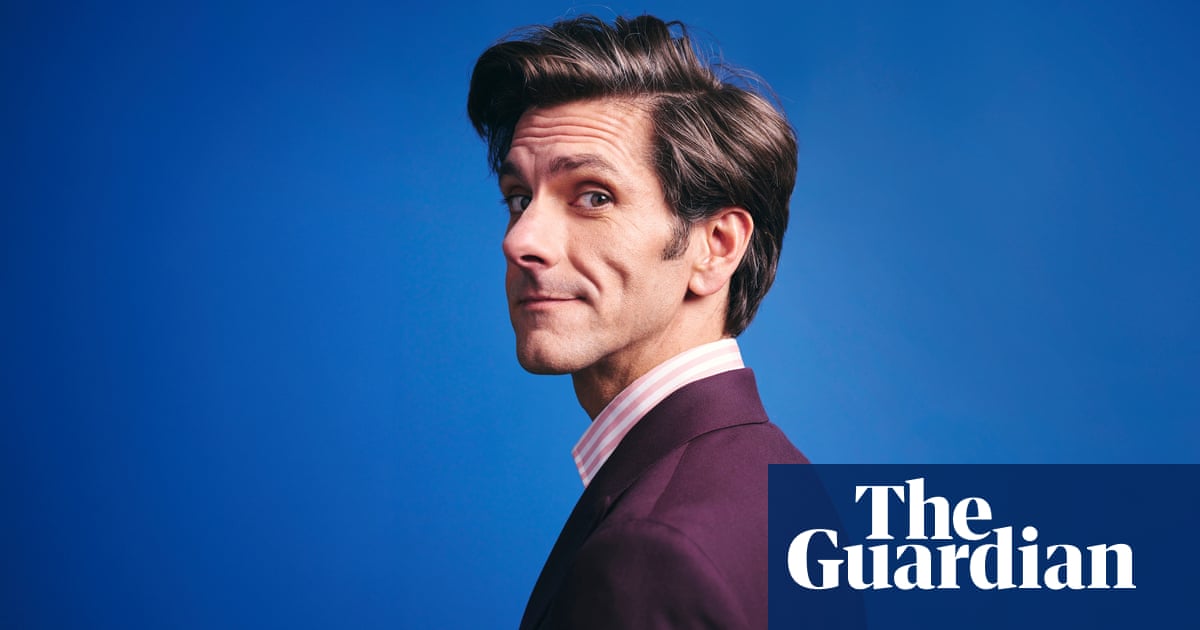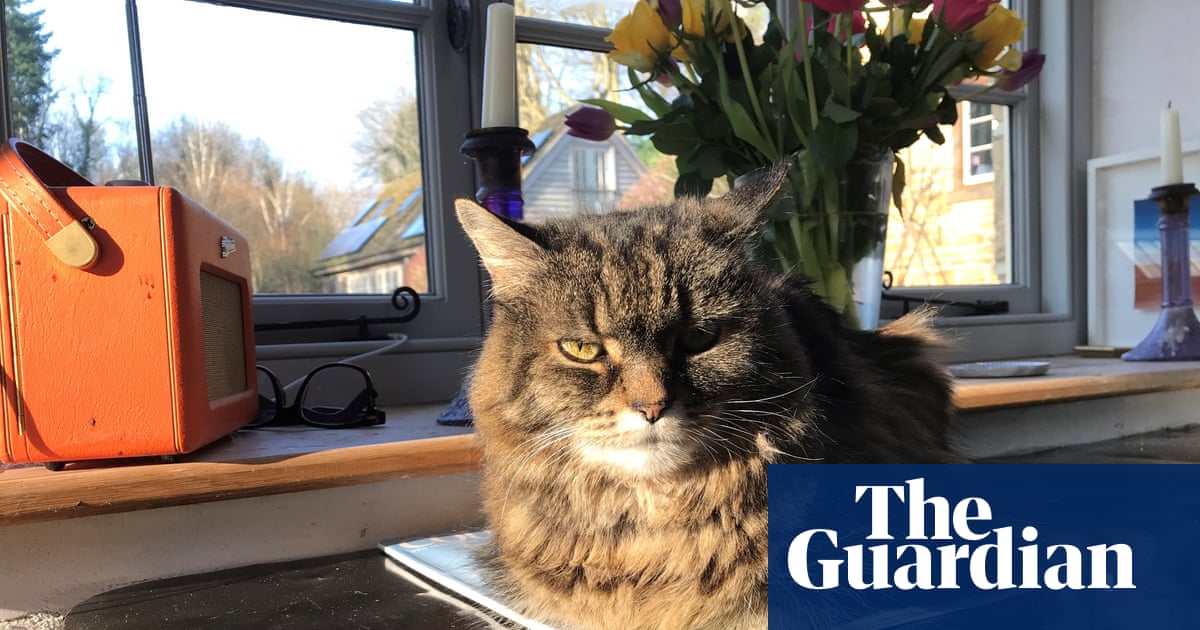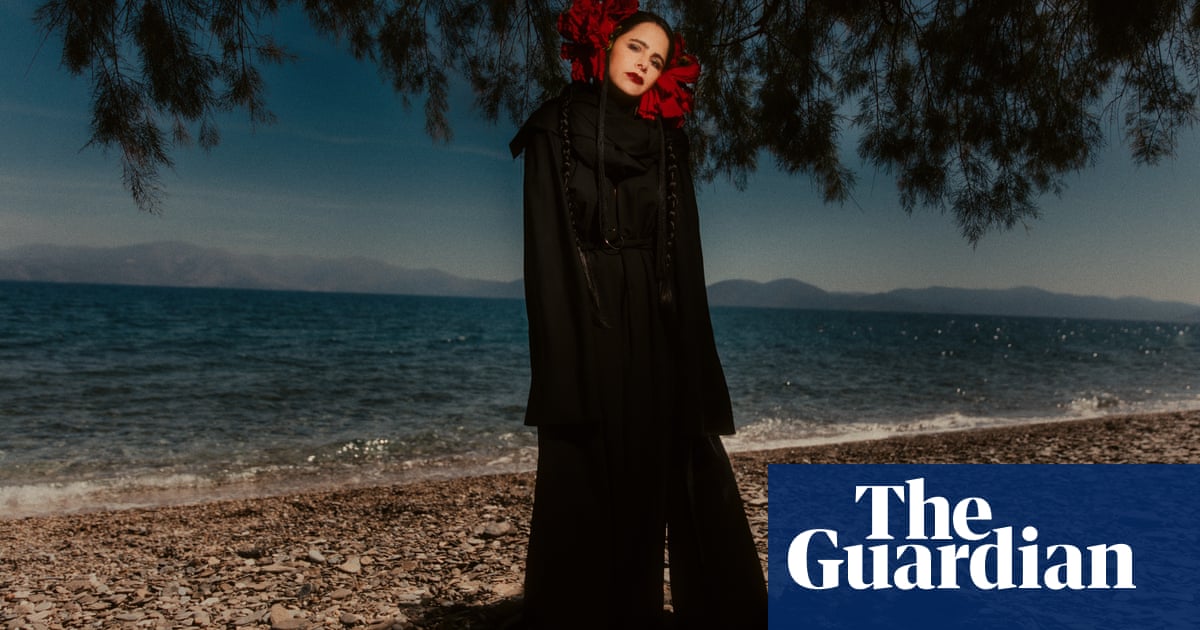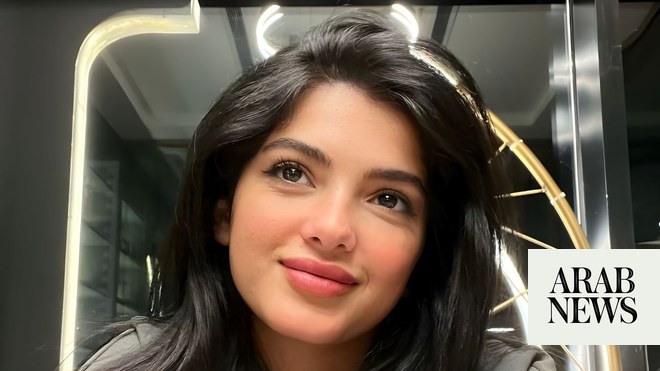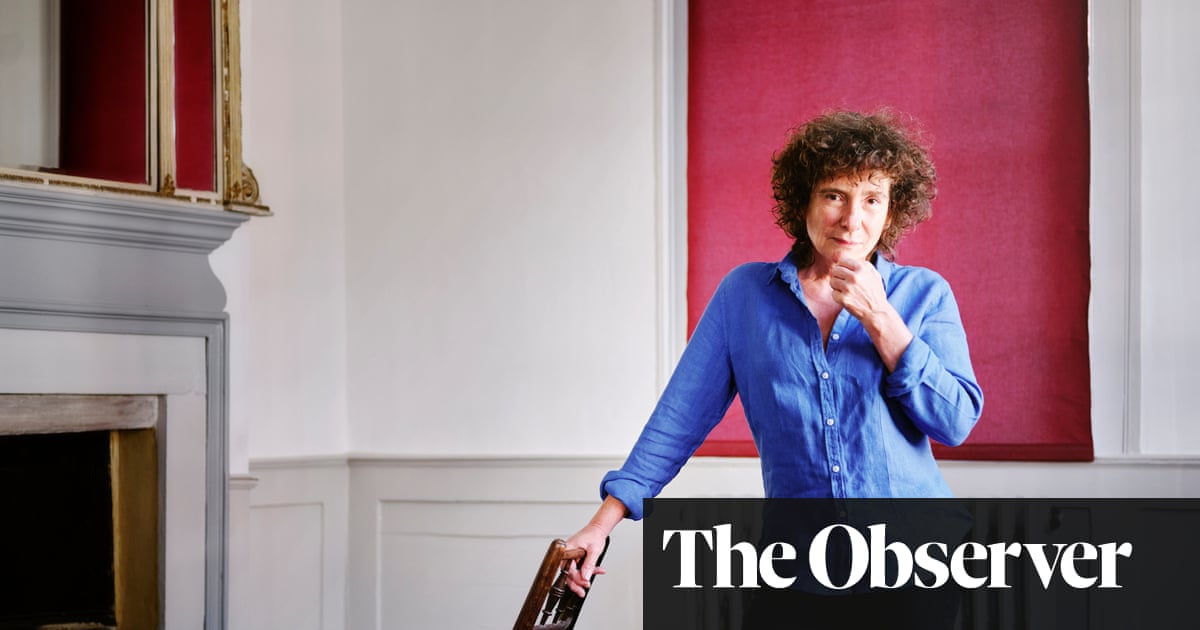
Some ghost stories start on a snowy night in a creaking castle, others start with Jeanette Winterson bustling into an east London restaurant on a hot day and ordering two glasses of pink fizz. Over the course of a long afternoon she will talk about fear, peacocks and the past; she’ll walk me through her haunted home and discuss the end of the world in such a way that it seems like actually it might be quite jolly. By the time I emerge into the evening I’ll be equal parts disturbed and charmed – and possibly changed.
Night Side of the River, her new book – the 23rd since Oranges Are Not the Only Fruit – is a collection of 13 ghost stories. Some are gothic, some explore technology, others are nonfiction, her own personal hauntings, but the thing that stood out for me was how none turn away from grief or death, a subject at the core of every ghost, yet rarely examined in its stories. Writing them, she enjoyed the genre constraints of a ghost story – inviting a reader into the room and then sort of moving the walls. “It’s like when you’re doing yoga and you think you can’t go any further. And then the teacher pushes you that little bit more? That open stretch.”
As well as the pink fizz we have ordered a full and delicious white table clothed lunch, and she is paying, she insists, because she can and because she likes to. “I was interested in writing about how we manage what can’t be explained,” she says, “which is often our deepest feelings of grief and loss and pain and heartbreak, and this thing that every human being comes up against, you know, Shakespeare’s undiscovered country, ‘from whose bourn no traveller has returned’.” She takes a delicate mouthful of beef. “We, as humans, are always trying to get past our limits. And this is the limit that we can’t get past.”
In Oranges Are Not the Only Fruit (which catapulted her into the rare space of the celebrity author) and, later, her memoir, Why Be Happy When You Could Be Normal? (the question her adoptive mother asked when 15-year-old Jeanette told her she was in love with a woman), Winterson wrote about her aggressively religious upbringing and path towards preachery. And though religion is now far behind her, she often peers back at it in her rearview mirror. “Religion was the first startup, because what it was disrupting was death.” Religion suggests that death is an illusion, and in some of her new stories she wonders whether religious people like her mother were right. “So what would that mean, if death is not any more?” We chew thoughtfully. “My own view is that Homo sapiens have reached their limit.” I stop chewing. “It is time to augment. I think the transhuman future is a good one, and I think the post-human future will be better.” A fellow diner sits open-mouthed, listening, a fork of tomatoes hovering below his mouth.
When considering such ideas as “the soul”, or spirits, as she does, regularly, weaving between ideas of old ghosts and what new ones might look like, she suddenly wondered, have we been telling the story backwards? “The one question everybody’s asking now is a very simple one: is consciousness obliged to materiality? Religion has always said no. Science has always said yes. Now, science is saying, ‘Hmmm.’”
She continues slightly dreamily, about the future of AI, non-biological beings that aren’t subject to bodily constraints, but stops, remembering this future is controlled by billionaires, and not, unfortunately, Jeanette Winterson CBE. Which is an issue. The “metaverse,” she says, “could be a really good place for people to try out identities and have these other selves. That’s what always was so attractive to me as a fiction writer, that you could inhabit other identities. Which gives you more understanding for yourself.” She wonders, “Is this now a trajectory towards the post-human, not just as an ending, but also a new beginning? We are an evolutionary species. It’s possible.” A dignified shrug. Doesn’t it terrify her? “Not at all.”
When Winterson was five, she’d read to her grandmother, who was bedridden and unable to speak due to throat cancer. One morning, she remembers her rising from bed, walking to the window overlooking the garden and saying, “Look at the Queen of Denmark.” Winterson scrambled to join her – she touched her hair, then walked through the window and along the rose hedge. At that moment the phone rang. Her mother came downstairs and picked it up, but the line was dead, and when she and Winterson returned to her grandmother’s bed, they found she was, too. That was her first supernatural experience.
Looking back at old interviews, I was shocked at the pitch of criticism she received in the 1990s, at the height of her fame, when her life was read even more closely than her books. In her Desert Island Discs from 1994, Sue Lawley repeats in disbelief both Winterson’s claims to be a direct literary heir to Virginia Woolf, and the time she nominated herself as writer of the year, asking incredulously, “Why do you do those things?” And Winterson responds simply – because she believes it. Accusations of arrogance became part of her story. “I know the seductions of telling a good story,” she says, today, “but there were times it was very hurtful, very difficult.” She remembers being quite bewildered by the negative reception she received. “I thought you could say what you thought to be true.” These days, she thinks, young women understand patriarchy in a way she didn’t, “the asymmetry of the world. I didn’t realise the bigger things that were not in any sense about me.” She eventually learned to deal with the criticism, “because I understood that in many ways, I was just the fall guy. I was the one who was standing, and therefore could be shot down. “But it made me very crazy for a long time.”
She briskly tells me the myth of Sisyphus, where it’s not one thing or the other that leads to madness. It’s the space in between. “And the space in between what I was trying to do – trying to live a dignified, successful life as a queer, working-class woman and being proud of that – and the hostility… I used to have this dream I was skiing too fast downhill and my skis were coming apart. Because they were.” She thinks for a second, sipping her drink. “Maybe I was fortunate because my crazy upbringing,” by which she means growing up the adopted child of evangelical parents who locked her in the coal hole and performed an exorcism on her when she fell in love with another girl, leading to an adolescence living in cars and tents before being accepted into Oxford University, “may have protected me.” How? “I was expecting to be misunderstood.”
This summer she went to the Glyndebourne festival and was deeply cheered when she went to the loo and discovered they had gender-neutral toilets. “Nobody was batting an eyelid, so don’t tell me this couldn’t work anywhere else. We’ve all got to get over ourselves and realise that things are changing.” Winterson has been writing about gender, its limits and possibilities, quite radically and with some glee for decades, and finds herself in a time of “gender wars” with some bemusement. “I’m still trying to find out how to think about it. Without using what I know to explain what I don’t know, which is a real trap of getting older.” Sitting there, on the loo, she thought about the possibilities of the post-human future, “and I thought, ‘What body would I choose?’” She thought, OK, she likes being small, but she’d like to be four times stronger. And she would quite like pointy little ears and possibly hobbled feet. Pixies, elves, all these things have manifested themselves throughout history, she reminds me, as have ghosts.
“The silly thing to do, I think, is dismiss things we can’t explain or that we don’t have any way of measuring. Maybe,” as her ex-wife, the psychoanalyst Susie Orbach believes, “it is a phenomena of brain disturbance. But, on the other hand, many people have experienced things they found extremely weird.” There was a significant rise in reported hauntings during the pandemic. Which suggests to Winterson, “that maybe we just have to shut the fuck up and be quiet to see ghosts. Come to my house and you’ll see why it’s very attractive to them. They love it there.” So she pays the bill and we trot the 50m or so to her London house, a Georgian terrace above a shop in Spitalfields, and when we arrive she calls up the steep stairs, “Hello, I’m back!” She’s talking to the ghosts.
One night, soon after moving in, Winterson was woken by the sound of clattering footsteps coming down the wooden stairs into her room. As she fell back to sleep, she felt a cold hand taking her pulse. She said, out loud, “I am alive,” and there was a rush of air before the footsteps retreated back up the stairs. That was her second supernatural experience.
In the corner room upstairs, a friend has painted a sign which reads, “A Restless Life”. “Yes, I’m all about movement. In my head and myself. If I were a dog, I’d be a terrier. I have to be moving on.” She sits beside the fire and I sit opposite, in an armchair where she tells me another ghost often joins her – a friend, staying in her absence, awkwardly confessed she’d seen her, a woman in a grey dress. There is a dead man, too, Winterson explains, in her typically straightforward way, who opens doors and throws the fire grate across the room and turns the radio on. When she bought the house, in 1994, it took her two years to make it habitable. In one room, a huge hook was bolted to the middle of the ceiling. The room next door had been an office and, clearing out a filing cabinet, she found a noose. “I really did wonder,” she says, lightly. The city is so saturated with stories, she believes they can’t help but emerge, no matter what you build on top of them. In those early days when she’d just moved in, the area part-derelict and being rebuilt, her neighbours would regularly return home, “and find the entire contents of their house in disarray, just moved around for no reason. The area had been so poor and so neglected for such a long time, there’d been no real disturbance and suddenly we all started disturbing it.” The dead, she reminds me, don’t like to be disturbed. “There was a cat that used to walk in and out of houses – eventually we realised it wasn’t alive.” This matter-of-fact way she has of talking about the supernatural comes in part from her childhood. Her adoptive mother blamed mice on ectoplasm. “Often, in life, we seek not to know,” she writes in her ghost collection, Night Side of the River, “not to name, or to re-name, and de-name. It’s not mice (we’re cold, poor, dirty). It’s ectoplasm. We’re special.” It occurs to me that perhaps Winterson is continuing her mother’s tradition. But growing up in poverty yet wrapped in faith, what could they do but expect other-worldly encounters? Her father told her about the night when, as a soldier in the Second World War, he returned to Liverpool on leave too late to catch the last bus. Another soldier, introducing himself as Stephen, showed him into an evacuated house, where he slept. The next morning he woke to find every house in the terrace had been bombed except his. When he asked in the pub the next day, he learned Stephen, who had lived in that house, had been killed the year before. “Humans can see less than 1% of the electromagnetic spectrum,” Winterson writes. “We call this visible light. We can’t see radio waves, gamma rays, X-rays, ultraviolet light. We manage just fine. Our mistake is to rename visible light – what we can see – as reality.”
Her beloved friend, the late writer Ruth Rendell, didn’t believe in ghosts until one night in a Cuban hotel, when she heard laboured breathing. “If you haven’t had such an experience, and then you do, you’ll change your mind. Or at least you’ll open it.” Soon after Rendell had died, Winterson was thinking about her as she turned on her laptop. For a single second, an image of Rendell’s smiling face flashed across the screen.
On her phone she shows me a photo – a pair of peacocks are squatting in her garden in the Cotswolds. She’s considered eating them, but hears their meat is tough and, besides, “it wouldn’t be right to shoot them; they’re so slow, it’d be too easy.” Their grandness compared to their tiny brains made her think about human brains and how we’ve learned to outsource mental capacity. “I don’t think technology is our enemy. It’s like when your horse is out of control the thing to do is to kick on and go faster. If you panic you lose control. So I think we should kick on and give this,” meaning AI, an antidote to death, the future, “our best chance. This is our evolutionary journey, whether we like it or not.” Sitting among her poetry books, scrolling through pictures of the peacocks I wonder what they symbolise in literature and, very quickly, answers, “Immortality.”
The evening before sending her final pages to the publisher, Winterson heard a loud thump on the headboard of her bed, followed by a tremendous racket in the corner room. She shouted into the house that she needed to get a good night’s sleep. There was a silence she describes as “sulky”. Now, the radio still switches itself on in the kitchen, but never before 8am, which, she says, is decent of them.
As evening approaches I creak around her house, listening carefully for doors, or the pattering of feet, but the sun and the drink, and the tourists outside are distracting, so I return to the corner room with the fire, unlit. “I don’t get scared of the dead,” Winterson says, sighing. “It’s the living that scare me. I’m not worried about ghosts – I’d rather spend the night in a haunted house than in Romania with Andrew Tate.” These men, she despairs of these men, who are hijacking our attention, and colonising technology, and setting the world on fire. “But why are we obsessed with the end? Human beings can’t live with themselves, I suppose, and so dying is always easier. Anything is easier than picking yourself up and carrying on.” She has hope that we can make a future that would include these bodies and this planet, but wouldn’t be restricted to it. But, “I’m very happy to have lived in this time.”
It’s almost 30 years since the publication of Oranges Are Not the Only Fruit. Winterson has recently turned 64, and she’s started looking back at the 40 or so years since she wrote it, and wondering if she’s used her restless life well, if she’s done the work she wanted to do, if she’s done some good. “That is enough for me. And that’s why I’m not afraid to die. I’ve done the best I can. I’ve lived the best life for me, just by carrying on doing it,” she chuckles. “It’s like 3D printing. I now know that that’s how you build a life – layer by layer. It’s incremental. Print one and then another and then…” a look of terrified wonder, “‘Oh, I’ve printed a spaceship. Bye!’”




